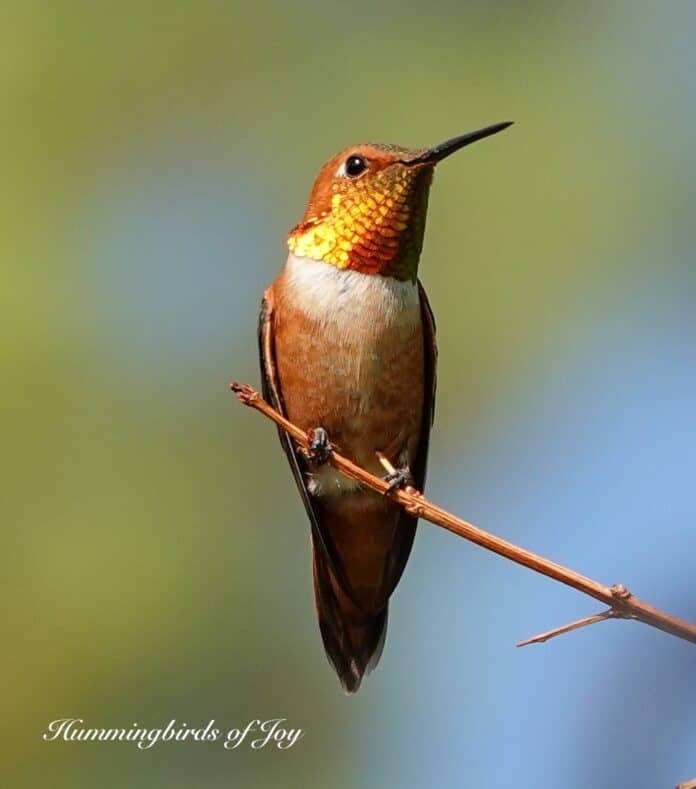
Susan Bonfield, Ph.D., director of Environment for the Americas, gave a talk on “The Remarkable Journey of the Rufous Hummingbird: An Update on Protecting the Joy” during this year’s Sedona Hummingbird Festival at the Sedona Performing Arts Center on Friday, July 28.
The rufous hummingbird, which weighs about as much as a dime, covers over 3,000 miles during its migration from its breeding grounds in Alaska to its wintering habitat in Mexico, which is the longest migration by body size of any bird on the globe. Its small size and its habit of crossing multiple artificial borders make it a challenging species to study, although it appearsto be under threat from intensive agriculture, climate change and pesticides.
“We know that this is a species in very serious decline, and we don’t know why,” Bonfield said. “The current estimation of the population numbers is about 22 million … we think that it has decreased by one half from 1970 to 2019.”
That trend is based on data collected from the Breeding Bird Survey, a large-scale bird monitoring program that has been active for more than 50 years across North America and keeps track of over 700 different species. On the basis of that data, Bonfield observed that the Allen’s hummingbird is another species whose numbers have fallen by half since the 1970s, which has led both birds to be identified as tipping point species.
“A tipping point species is one that indicates concern that it will lose another half of its population by the year 2050,” Bonfield said. “Other bird species are experiencing the same decline. In fact, scientists believe that we’ve lost over 3 billion birds since 1970.”
Studying hummingbirds comes with special challenges, including the specialized training needed to be able to band them, and the fact that they are too small to be tagged with GPS trackers.
“It’s hard to identify a bird that flies at about 30 miles per hour,” Bonfield said. “They also don’t flock like ducks and other bird groups, so you can’t capture them in one place at one time. Other reasons [are] they don’t sing. They don’t sit at the top of a bush and sing a beautiful song.”
“Even the Breeding Bird Survey data, that is a survey that takes place early in the morning and depends largely on song as well as on sight. If you’re not hearing a hummingbird, it could be sitting over your head. You never know it was there.”
Bonfield described how, for the past year, Environment for the Americas has brought together biologists, educators and land managers from Canada, Mexico and the United States to discuss threats to migratory hummingbirds. Environment for the Americas has identified industrial agriculture as the top threat to the birds. Areas of industrial agriculture have been expanding into hummingbird habitat on both sides of the Mexico-United States border, particularly in the area around Salinas on the Central California coast.
“In recent years, the number of farms in the United States have declined,” Bonfield said. “There aren’t as many farms as there used to be. But agriculture itself has changed. It’s no longer a small family farm that’s providing our food. Now, agriculture has grown and intensified so that it covers more acres, but fewer farms, but is more intense,so that it can produce more food for us … They’re all intensively treated with fertilizers, pesticides and herbicides.”
Pesticides can work their way up the food chain from soil to insects and into the nectar that hummingbirds consume. In a ruby-throated hummingbird, for example, insecticides can suppress respiration, reduce appetite and impair physiology.
Climate change is also affecting the food supply along the rufous hummingbird’s migration route through the Rocky Mountains. Bonfield pointed out that the birds are now trailing about two weeks behind the first flowering plants that emerge from the snowline because spring is now arriving earlier. However, Bonfield also identified several steps people can take in their homes to contribute to hummingbird conservation, including planting native flowers, purchasing sustainable plants and flowers, avoiding chemical use at home, making home windows visible to birds and regularly cleaning their hummingbird feeders.
“Hummingbirds are pollinators and they pollinate some of our most beautiful flowers [and] we want to keep our flowering plants around,” Bonfield said. “So planting native flowers is critical for the continuation of our flowers at the same time. It’s also important because they get more nutrients from their native flowers than from the nectar from your feeder.”
For more information about the International Hummingbird Society, visit hummingbirdsociety.org, or if interested in Environment for the Americas, visit environmentamericas.org.


















